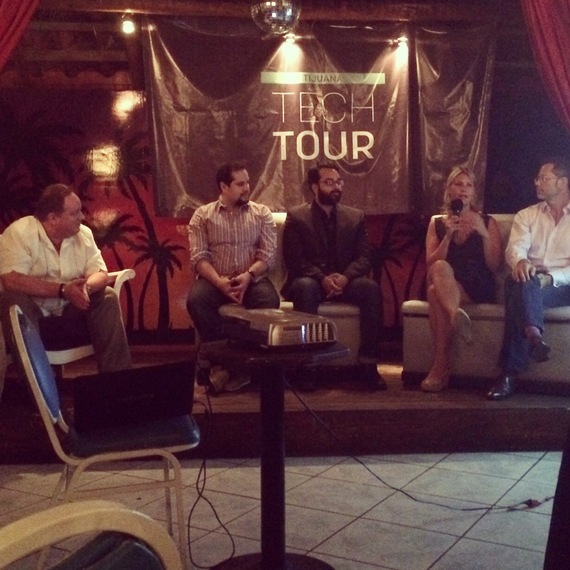It was raw and I had heard murmurings of innovation stirring south of the border. My interest was piqued when I was invited by Angel Ventures Mexico to participate in the Tijuana Tech Tour. Admittedly, I was skeptical about this emerging tech scene in a border town perhaps better known for discos, mezcal and strip clubs.
Uber had just launched in Tijuana. An abandoned bus station on the Tijuana strip, Avenida Revolucion, had been converted into the Hub Stn, a co-working facility for tech companies. And one of the biggest drone companies, 3D Robotics, had set up shop to take advantage of the inexpensive labor and operating costs.
I had to see for myself.
My decision to travel to Tijuana with 19 other investors, leaders and entrepreneurs from Mexico and the United States on the #TJTechTour was met by my friends and family with bewilderment and concern.
"Tijuana? Be careful!" was just one of the many comments posted on Facebook by a friend looking out for my safety.
The biggest problem in Tijuana or "TJ" as it is often called is not violence or drugs -- it is branding. Today, Tijuana represents a gateway to Latin America and a real opportunity for those who can see through its gritty image.
The Mexican border town just south of San Diego has over two million inhabitants. The two cities represent a binational region with over 40 million people crossing the border each year. Their economies, cultures, people and environments are so intertwined, it's more like one state: the "CaliBaja Mega-Region."
"Tijuana is just like the state of California, but a little dirtier and less expensive," said Marcus Dantus, a Mexican entrepreneur and co-founder and CEO of Startup Mexico and Founder of Wayra Mexico who joined us on the trip.
Jorge Astiazaran, the mayor of Tijuana, kicked off our three day Tech Tour at Hub Stn to an audience of civic leaders, investors, and entrepreneurs. We were there to carry on the conversation as technology transcends borders.
Tijuana may never be the epicenter of software and technology innovation that Silicon Valley is, nor does it purport to be. Instead, it is positioning itself as the bridge between the United States and Latin America using technology as a platform to drive innovation in its manufacturing businesses and as a hub for entrepreneurship in the binational region.
The border town has highly skilled engineering talent with an international mindset and is in close proximity to the United States, ideal for nearshoring. With manufacturing moving from China to Mexico, and American trade with Mexico having grown 30 percent since 2010, Tijuana has a real opportunity to drive innovation in manufacturing through technology.
Case in point -- the first stop on our Tech Tour was at the manufacturing facility for 3D Robotics, a state of the art drone business. The VC backed company is based in Berkeley, has engineering facilities in San Diego, and manufacturing in Tijuana -- an increasingly common post-NAFTA model.
Home to the Tijuana University of Technology, the city's local engineering talent source has also spawned several tech accelerators and nearshoring companies that we visited including Sonata and MindHub. These companies work with both American and Mexican companies to provide engineering needs with skilled talent at a lower cost and close to home. For earlier stage companies, co-working facilities like the BitCenter and HubStn are popping up as affordable places for visionaries and engineers to build their dreams in Tijuana.
And the bridge goes ways. American companies looking to enter markets in Latin America often seek market validation in Tijuana, given its binational culture, before moving into the rest of Latin America. While Uber already has a presence in Mexico City, the company just launched this past month in Tijuana.
The international community also has its eyes on the region. In 2016, Tijuana and San Diego will host the World Forum for Foreign Direct Investment, which will be the forum's first binational location.
Our savvy local guides, also helping to lead the Tijuana Tech movement, were keen to introduce us to the fusion cuisine, art galleries and budding cultural scene emerging in Tijuana -- all instrumental in reshaping the city's brand. The Culinary Art School in Tijuana requires that its students spend time abroad to learn to appreciate and incorporate new flavors into their cuisine. The food was exquisite and stimulated conversations among our group and dreams of building new bridges.
Just as Silicon Valley has Napa, the Baja Peninsula boasts its own Wine Country and Ruta del Vino (wine route) in the Valle de Guadalupe region -- an hour and a half south of Tijuana near Ensenada. On Saturday, we wound along the unpaved roads through the beautiful valleys, visiting local wineries and stopping to dine at Finca Altozano, a rustic al fresco restaurant with an open kitchen that overlooks the vineyards. Javier Plascencia, the owner and chef, is a well-known Tijuana restaurateur known for his Baja Med cooking style and for revitalizing the culinary scene in the region.
While there's rich conversation and real energy around technology and change in Tijuana, the border town can't do it all alone. There must be an ecosystem built to support it, throughout Mexico and with its neighbors. I'm hopeful that with the right investment and entrepreneurial mentality, new creative solutions will emerge to address some of the other issues in the region from banking to logistics and help to rebuild the region's image.
